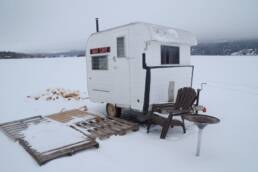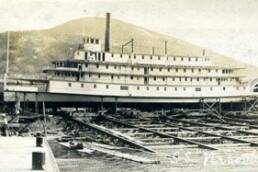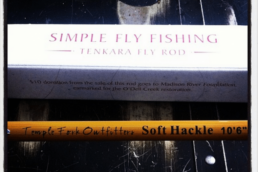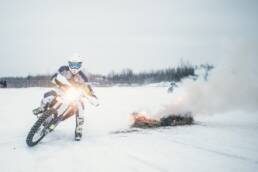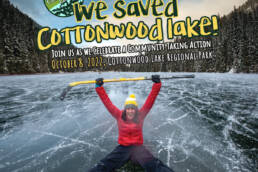In the dead of winter, we used to angle for them. Kids stared at them in awe. And the fish and chips were tops. Following an era of over-recreation and lakeside development, KMC Senior Writer Dave Quinn reflects on the frozen memories of an amazing East Kootenay lake bottom beast, and a strange future that followed.
I can’t shake a certain, early 1980s, winter memory from my childhood. I am eight-years-old, and it is as crisp and clear as the waters that created it, frozen into my brain. I remember riding with my dad out onto the frozen surface of Lake Windermere, British Columbia. Driving! On a lake! What the…?
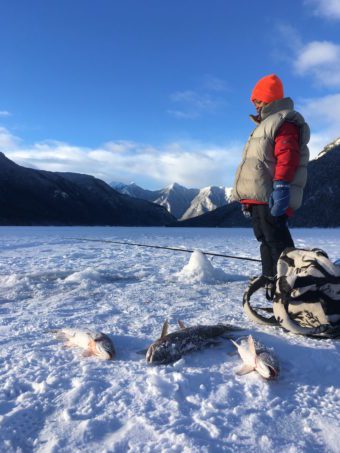
Tempting fate with several tonnes of truck on nothing but ice was not enough for a young lad to process (“If we break through, David, open the doors so the truck will hang up on the ice and we won’t sink.”), we were headed towards an entire community, a man-pad, shanty town comprised of dozens of ramshackle, ice fishing huts, complete with its own mayor.
But what I remember most clearly is what followed: the excitement and sense of belonging, of entering the Club, when we were invited into one of those shacks. Radio blaring. Woodstove glowing in the corner. Beers and cigarette butts scattered on a table. And, a four-butt bench overlooking a huge rectangular hole in the ice.
In the dank, musty dark of that shack, the two-foot by three-foot, chain-sawed hole in the ice literally glowed with the light of a Kootenay, winter sun filtered through snow-covered, green-blue ice. Down below, swimming over a silty lake bottom less than 10 feet away, was a jaw-dropping aquarium of fish.
I had never seen so many fish in one place in my whole life. Dark, snake-like forms entered and left our chunk of lakebed in what appeared as a continuous stream, in sizes ranging from forearm’s to full arm’s length, and longer. These were the burbot, either the prize fish of Windermere Lake or a total nuisance, depending on whom you asked.
Burbot (pronounced either to rhyme with ‘robot’ or ‘ribbit’, affected by which East Kootenay dialect you encountered) are a freshwater ling, from the cod family. For thousands of years people filled their bellies with the ling’s tender, white meat, easily procured during the February spawning season, when thousands upon thousands of burbot gathered to mate off the mouths of small streams.
Today the burbot of Lake Windermere are all but gone.
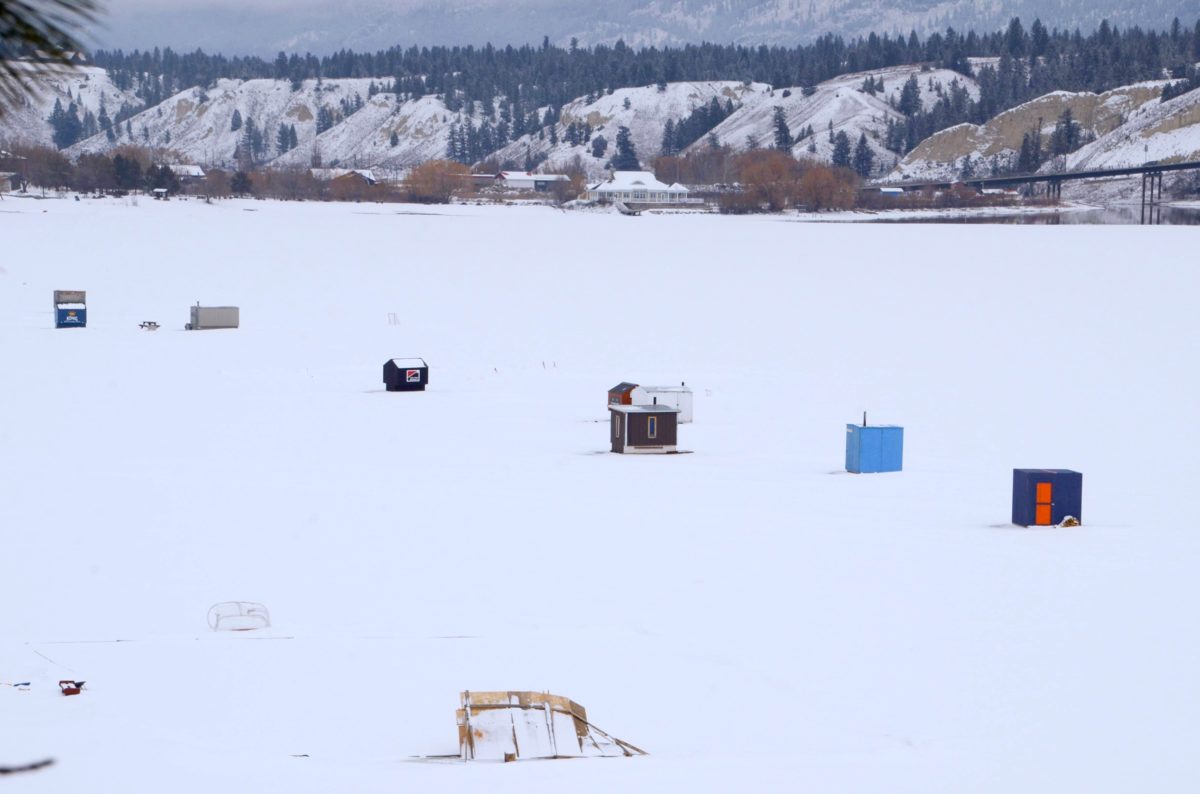
“MY DAD BUILT my first shack from an old, two-seater outhouse,” says Invermere’s Mark Swindell, who is also my uncle, and the owner of the shack I visited those decades ago. “Some drunken idiot drove over it and a bunch of other shacks one weekend, though, and with the money we got out of him I built my own.”
He grew up in Windermere, in one of many families who subsisted from the land and lakes to fill out the year’s meal plan. “My dad and all the old-timers used to fish with a set-line strung between two holes in the ice, from late November until about New Year’s, when the ice would get too thick. You’d put fist-sized chunks of other fish, suckers, whitefish, on the hooks so only the bigger ling could take the bait. All the ling and trout would be kept, and all the suckers, whitefish, and what they used to call squawfish, now known as pike minnows, would be just chucked on the ice.”
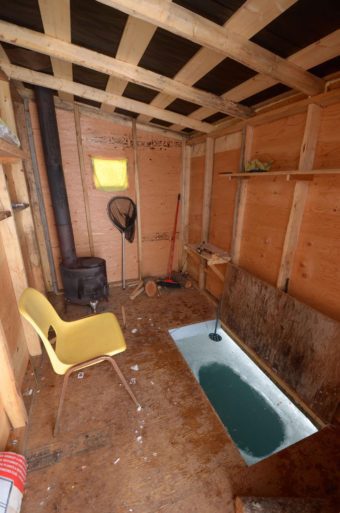
Swindell recalls local First Nations people coming down to the ice on horse-drawn wagons to collect all the fish that white people left behind. “It was years later I learned that they were making roll-mops, pickling them.” Pickling fish dissolves many of the bones that well-heeled fishers turn their noses up at, and is a fish preservation and preparation method practiced around the world.
“Eventually set-lines were banned, and people fished with spears,” continues Swindell. He disappears into his garage and reappears with an old, two-handed ice saw that towers over him and a deadly-looking device that seems better suited to a Game of Thrones battle scene than for spearing fish. A pair of scorpion-like pincers snap closed when the spear is thrust down on the back of a fish. Deadly efficient, all from the comfort of a wood-heated, ice fishing hut.
In the late 1960s, burbot were finally declared a “sport fish,” which meant that it was suddenly illegal to spear them. Fishermen began to focus their baited hooks on the February spawning season, and the fishing was good. The proliferation of burbot prompted the Windermere Community Association to host an annual Ling Derby during the February run. The event was huge for locals. “There were plane rides, snowmobile rides, it was a huge event,” recalls Swindell, who won the $100 first place prize in 1970 for the longest ling—a 1.25-metre monster.
“I remember some ice divers came from Calgary one year, and made a big fuss about a strange new creature they discovered under the ice. There was a big deal and surprise, up they bring an octopus! It was all a big joke and a great time.”
The event was huge for locals. “There were plane rides, snowmobile rides, it was a huge event,” recalls Swindell, who won the $100 first place prize in 1970 for the longest ling—a 1.25-metre monster.
But, on a micro-scale version of coastal fishery plundering, people abused the resource. Smaller burbot, often called freshwater ling, although not closely related to the real saltwater ling, were just tossed on the ice. Quotas, first set at 20 fish, then reduced to 15, were ignored. Swindell recalls garbage bags full of small ling thrown into the local dump.
In the 1980s, average burbot lengths of 50 centimetres were common, with many of the larger females exceeding 100 centimetres. Today, ling are exceedingly rare, and fishermen are not allowed to keep them. They are a regionally threatened species.

Like any ecology story, there is no simple answer. While overfishing was certainly one of the main issues leading up to the collapse of the burbot population, lakeshore development and industrial impacts on spawning channels also played a role. Small ling like to cruise the shallows, and the shores of Windermere Lake have seen disastrous changes due to human recreation as well as infrastructure and real estate development in recent decades.
“They are an amazing fish,” continues Swindell. “I have seen them come back to life after being frozen completely solid. They can eat other fish near as big as themselves! And they make the best fish and chips on the planet.”
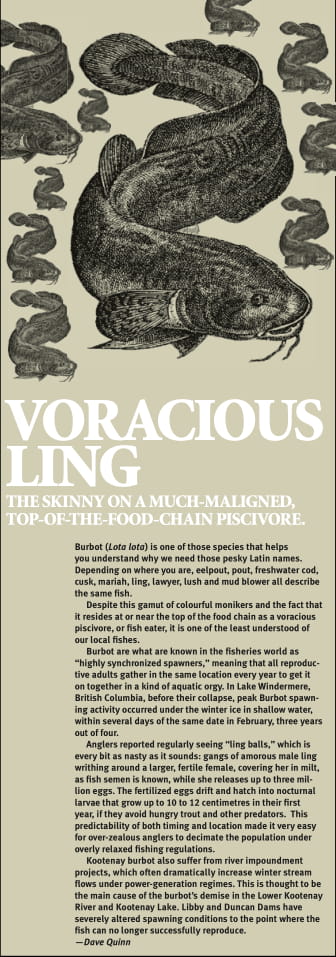
I RETURN TO THE ICE of Windermere Lake 30 years later to see what remains of the ice town and the Kootenay aquarium I remember from my childhood. Just over a dozen shacks dot the lake, with only four in front of Windermere Creek, where the ice town once stood. Not a soul is fishing on this perfect Saturday morning. So I steel myself for a Darwin award, and drive out onto the ice, following tire tracks across the lake to a group of pickup trucks parked along the far shore. Here I meet retired farmer Ken Hoover, and am introduced to the modern version of ice fishing.
Sitting in his truck, engine on, heater and speakers blasting hot air and music, he intently watches a large screen set between the front seats as he jigs a tiny fishing rod out his driver’s window. His line goes through 60 centimetres of clear ice into the shallow water below, while the camera on a wire goes down through an adjacent hole, allowing Ken to watch fish approach his lure.
“This is ice-fishing!” grins Hoover, from beneath a green, Bass Pro ball cap and Kootenay-issue, green plaid, flannel jacket. “Mostly just pike minnows, which used to be called squawfish, and suckers today. I caught a nice bass yesterday. Here comes one!”
On the green-tinged screen, a golden, shimmering bass glides near the lure, but doesn’t take it. Ken spins the camera, and I see the modern version of the aquarium of my youth. Instead of viewing a writhing sea of spawning burbot, dozens of bass, pike minnows, and suckers glide slowly around in the camera’s field of view. I am witnessing first-hand the new reality of Lake Windermere: a golden, shimmery community of bass and pike minnows.
According to a 2008 report on the lake, much of the native fish community of 16 species, including bull and rainbow trout, dace, three species of chub, Kokanee, sculpins, whitefish, shiners, and two species of sucker, have been replaced by introduced, large-mouth bass. These bass, along with northern pike minnows, now dominate the predator roles in the lake, replacing the native populations of burbot, trout, and Kokanee.
Soon several other trucks arrive, and the sound of gas-powered, ice augers fills the air. By the time I leave, the ice is dotted with cast-aside pike minnow, suckers, and other less desirable fish, heaved up through the ice and thrown aside to slowly freeze to death. “Feeding the eagles” is what the ice fishermen call it. All that incredible, local, high-value, albeit boney, protein just left to rot on the ice seems out of place with most fishermen’s claims of stewardship and fair play.
The dark forms of the eagles, sitting in nearby trees waiting for the fishermen to leave, however, seem to approve.
Dave Quinn grew up on a Kootenay diet of grouse, deer, elk, Kokanee, and trout. He loves fish and chips, and longs for the day local ling is back on the menu.
Dave Quinn
Born in Cranbrook, British Columbia, Dave is a wildlife biologist, educator, wilderness guide, writer and photographer whose work is driven by his passion for wilderness and wild spaces. His work with endangered mountain caribou and badgers, threatened fisher and grizzly, as well as lynx and other species has helped shape his understanding of the Kootenay backcountry and its wildlife, and help shape his efforts to protect what remains. His writing and photography has helped fill the pages of publications such as British Columbia Magazine, Westworld, the Financial Post, Backcountry, Adventure Kayak, as well as the Patagonia and MEC catalogs.
Related Stories
Calving Glaciers and Chasing Ice
This is oddly beautiful. The destruction, of course, is terrifying. At Coast Mountain Culture, we've watched an advance…
Introducing the New Sport of Ice Canyoneering
Dave Gorzitza takes writer Mary McIntyre deep into the frozen world of ice canyoneering, British Columbia’s chilliest…
Sick Pics from the Motorcycle Ice Rip
A small, grassroots event held on a frozen lake near Montreal, Quebec is capturing the imaginations of pro dirt bikers…
“We Saved Cottonwood Lake” Celebration
The Cottonwood Lake Preservation Society is holding an event October 8, 2022 to celebrate saving the regional park from…


